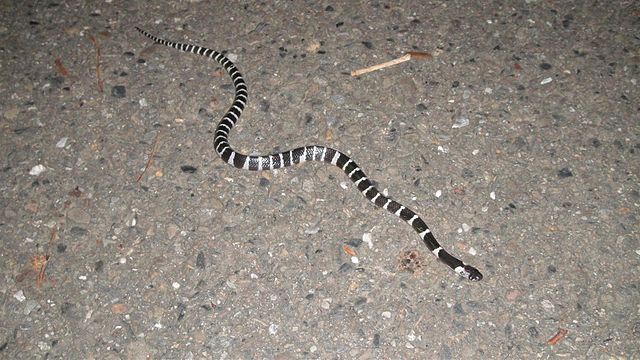Researchers say that snakes were the likely cause of transmission to human, but others dispute that notion.
A virus that apparently made the jump from animals to humans has sickened 881 Chinese and has killed 26 since the outbreak was first reported last month. The virus appears to have originated in a restaurant and market in Wuhan province (population 11 million) that apparently serves, among other things, wolf pups, bats, rats, and the Chinese krait (Bungarus multicinctus ) and Chinese cobra (Naja atra). It is from these reptiles that some believe the deadly infectious respiratory illness made the jump to humans.

Briston/Wikipedia
A Chinese krait is a highly venomous snake native to much of China and Southeast Asia.
Scientists in China were able to crack the genetic code of the coronavirus and with photographic microscopes, were able to take images of the virus that is responsible for the lockdown of millions of Chinese in 11 major cities. The coronavirus, dubbed 2019-nCoV, is transmitted through the air and infects the respiratory and gastrointestinal systems of mammals and birds. Scientists in China believe that 2019-nCoV made the jump to humans from the animals sold at the Wuhan market, according to ScienceAlert.
“Taken together, snakes could be the most likely wildlife animal reservoir for the 2019-nCoV,” the researchers wrote in a paper published on January 22 in the Journal of Medical Virology.
Five Facts About The Monocled Cobra
Initially, the scientists noted that the genetic code of 2019-nCoV was closely related to two bat SARS-like coronavirus samples sourced in China, but that notion was apparently disproved by a more robust bioinformatics analysis of the 2019-nCoV’s DNA sequence. That analysis suggests that the new coronavirus may have come from the two snakes. Protein codes that were favored by the new coronavirus were compared to those of other animals, including birds, marmots, hedgehogs, manis, bats and humans. The data concluded that, of the animals compared, 2019-nCoV protein codes were most similar to those found in the snakes.
Some though, question if snakes can serve as hosts at all.
“They have no evidence snakes can be infected by this new coronavirus and serve as a host for it,” Paulo Eduardo Brandão, a virologist at the University of São Paulo told Scientific American. Brandão is trying to determine if coronaviruses can even infect snakes. “There’s no consistent evidence of coronaviruses in hosts other than mammals and birds.”
According to news reports, China initially punished those who reported the new virus on social media, including journalists who reported on the respiratory and gastrointestinal illness, a move that some experts believe may have contributed to the spread of the virus. The communist country has since locked down travel. Wuhan has closed its airport and train stations as well as all public transportation services in the city. Huanggang, 80 kilometers from Wuhan, has also instituted a lockdown on travel. Cases of the virus have been reported in every Chinese province, as well as on Macao, Hong Kong and Taiwan. Singapore, France, Thailand, Japan, Korea, Vietnam and the United States have also confirmed cases of the virus within their borders.
An abstract of the paper, "Homologous recombination within the spike glycoprotein of the newly identified coronavirus may boost cross‐species transmission from snake to human," can be read on the Journal of Medical Virology website.


